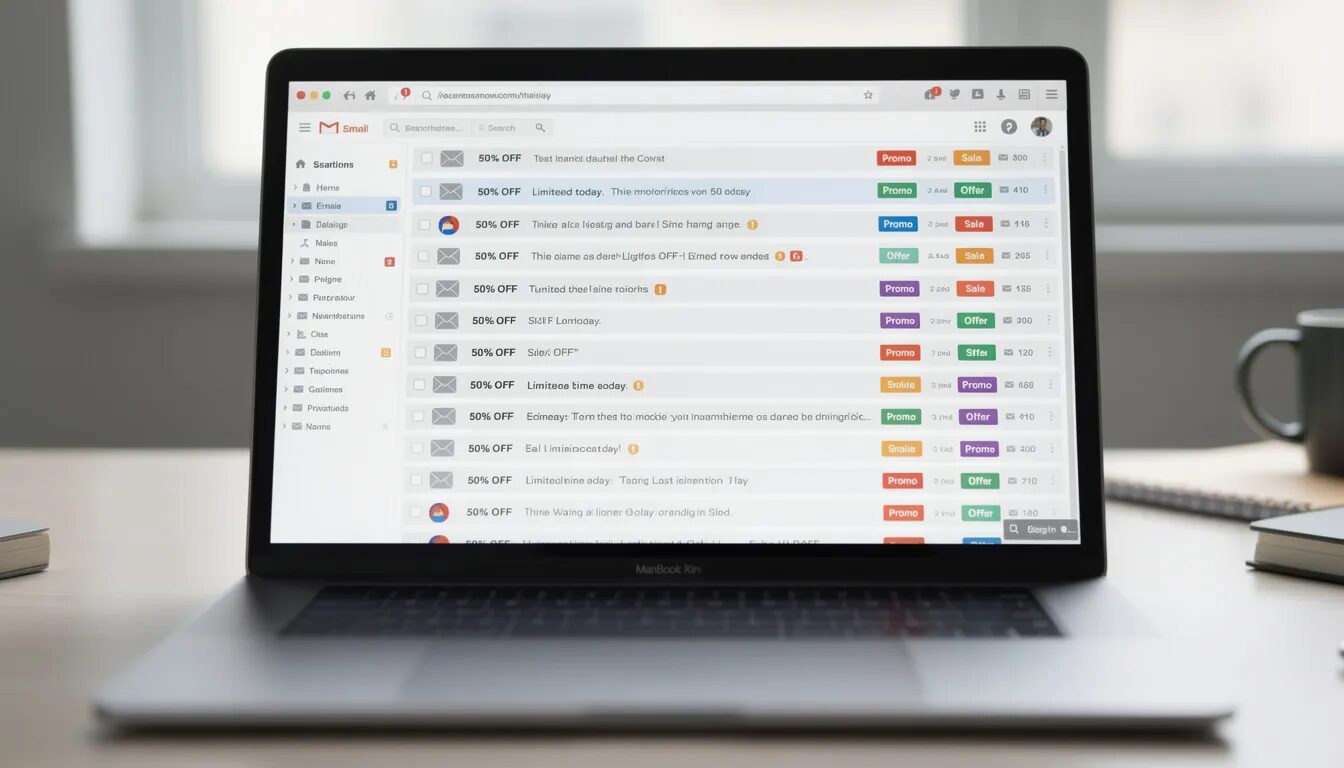
Open Rates Are Dying: Here’s What Actually Matters Now in Email Marketing
Open rates are dying; here’s what actually matters now in email marketing, largely due to privacy changes from companies like Apple that make these metrics unreliable. Open rates are no longer an absolute measure of true subscriber engagement. In this article, we’ll explore why open rates are falling out of favor and guide you through the key metrics and strategies to focus on for better engagement.
Key Takeaways
- Open rates have become unreliable due to privacy changes, making click-through rates (CTR) a more accurate measure of email engagement.
- Personalization and segmentation based on subscriber data significantly enhance engagement and deliverability, leading to higher email marketing effectiveness.
- Maintaining a clean email list and focusing on key metrics like bounce rates and unsubscribe rates are crucial for improving sender reputation and overall email marketing performance.
The Decline of Open Rates

The landscape of email marketing has been dramatically altered by Apple’s Mail Privacy Protection, launched in 2021. This feature anonymizes open tracking by requesting images before an email is even opened, leading to inflated open rates and misleading data for marketers. As if that weren’t enough, Apple made further adjustments in April 2024, altering their pre-fetching methods, which resulted in a significant decrease in pixel firing events, further contributing to the drop in reported open rates. Inaccurate open rates can also cause deliverability issues, as emails may be misclassified and potentially end up in the spam folder.
These changes have left most email marketers scratching their heads. The traditional metrics we once relied on are becoming less reliable. For instance, pre-fetching techniques used by providers like Apple can inflate open rates, leading to a false sense of engagement. The email open rate, once a key performance metric for evaluating the success of email campaigns, is now much less reliable due to these changes. This means that what you see in your reports section may not accurately reflect your audience’s actual engagement levels. Apple’s adjustments to their inbound filtering have also affected how open rates are tracked and interpreted, adding another layer of complexity.
Despite these challenges, tracking open rates still provides a valuable indicator of how engaged your audience is with your average open rate email open rates communications. However, many marketers have noted a decline in the open rate as changes in user behaviors and preferences become more prominent.
Navigating this evolving landscape requires understanding how your email service provider handles auto opens from Mail Privacy Protection users and monitoring compliance standards and trends over time with respect to inbox providers.
Why Click-Through Rates (CTR) Matter More Now
Click-through rates (CTR) have emerged as a more reliable metric for gauging email engagement. Unlike open rates, which can be affected by privacy settings and other external factors, CTR provides a clear indicator of recipient engagement by reflecting the percentage of recipients who follow links in an email. A high CTR suggests that your email content is relevant and resonates well with your audience, while a low CTR may indicate a need for improved messaging or design. Higher CTRs in marketing emails and promotional emails can directly drive sales by encouraging recipients to take action and complete purchases.
The design and structure of your emails play a vital role in determining CTR. A well-organized email with a clear and compelling call-to-action (CTA) encourages higher engagement. Optimizing the placement and clarity of your CTAs can significantly enhance the likelihood of recipients clicking through. While tracking open rates provides some insights, factors like email privacy settings can skew the data, making CTR a more reliable metric for assessing engagement.
Click-through rates also influence the overall effectiveness of your email campaigns. They act as a bridge between email opens and actual engagement, providing a more accurate picture of how your audience interacts with your emails. Marketing emails and promotional emails, in particular, benefit from high CTRs, as these types of emails are designed to engage recipients and drive sales. In essence, CTR indicates subscriber engagement and the effectiveness of your email marketing efforts, making it an indispensable metric for modern email marketers.
Engagement Metrics to Focus On
As open rates decline in reliability, it’s crucial to focus on other engagement metrics that offer deeper insights into your email marketing performance. Bounce rates, for instance, indicate the percentage of emails that couldn’t be delivered, providing valuable insight into the health of your email marketing list and email deliverability. Maintaining a clean and engaged email marketing list is vital for enhancing your sender reputation and avoiding spam traps. Regularly removing inactive subscribers from your list is important to improve deliverability and maintain high engagement.
Regularly monitoring key metrics such as bounce rates and spam complaints can help you maintain a healthy sender reputation. Additionally, A/B testing can lead to higher conversion rates by utilizing data to refine your email strategies for better performance. Optimal email A/B testing involves segmenting a portion of your subscriber list to ensure unbiased results, allowing you to make data-driven decisions.
Another crucial email metric to focus on is the unsubscribe rate, which reflects the percentage of email recipients who opt out. This one metric is essential for assessing audience engagement and understanding how well your content resonates with your subscribers.
Shifting focus from open rates to metrics like conversion rates and unsubscribe rates offers a deeper look into your email marketing efforts and helps make informed decisions to improve performance.
Personalization and Segmentation

Personalization in email marketing goes far beyond merely inserting a recipient’s name; it involves tailoring all aspects of the email based on individual subscriber data. Understanding and respecting your audience’s preferences is at the heart of effective personalization. For instance, personalizing preview text can make emails feel more relevant and engaging to the recipient. Emails with personalized content typically achieve higher click-through rates compared to generic messages, as they cater to individual interests.
Combining segmentation with personalization not only boosts engagement but also improves deliverability by signaling to ISPs that your messages are wanted by subscribers. Effective personalization requires comprehensive gathering and management of subscriber data, which facilitates better segmentation. Using email segmentation enhances content relevance, increasing the likelihood that subscribers will engage and act on your messages. Personalized and segmented email newsletters, in particular, can significantly improve engagement and conversion rates by delivering targeted content that matches subscriber interests.
Smart segmentation through AI allows for more effective targeting by grouping recipients based on behaviors and preferences. Successful email marketing systems often allocate a substantial portion of their teams to segmentation efforts, leading to significantly higher returns on investment. The integration of segmentation and personalization allows marketers to create standout email campaigns that resonate more deeply with their audience.
Importance of Deliverability and Sender Reputation
Email deliverability indicates whether your messages reach subscribers’ inboxes instead of being filtered as spam. Achieving high email deliverability is crucial for meeting your marketing goals, as undelivered emails can waste efforts and resources. Sender reputation, which is assessed based on your email sending behavior, subscriber engagement, and list quality, plays a significant role in email deliverability.
Strong engagement metrics can lead to higher deliverability rates, as email service providers favor senders with positive recipient interactions. Implementing proper email authentication helps build credibility with ISPs and improves deliverability rates.
Focusing on maintaining a clean email list and fostering positive engagement enhances your sender reputation and ensures your emails reach your audience’s inboxes.
Optimizing Subject Lines and Preview Text
The subject line is crucial in email marketing as it grabs the reader’s attention and helps prevent emails from going to spam. Personalized subject lines can lead to a 26% increase in open rates, making them an effective strategy for improving engagement. Incorporating effective preview text can substantially boost open rates, as it provides additional context that supports the subject line. Using an email template can also streamline the process of crafting these elements.
Utilizing the best tools and email tools can help test and optimize subject lines and preview text for maximum impact. Platforms like Mailchimp offers features such as subject line testing and preview optimization, allowing marketers to refine their messaging and improve open rates.
Using urgency and clarity in your preview text can enhance its effectiveness and encourage recipients to open the email. Preview text should complement the subject line, creating a cohesive message that entices the recipient to engage. Keeping preview text under 90 characters is recommended for optimal display across various email clients.
Avoiding repetition between subject lines and preview text helps maintain reader interest and prevents redundancy. Effective preview text can highlight key calls to action, guiding recipients on what actions to take next. Email marketers should also avoid spam-triggering words in subject lines to improve engagement.
The Role of A/B Testing in Email Marketing
A/B testing, also known as split testing, can help optimize various elements of your email campaigns for better performance. It provides insights into email performance, enabling marketers to refine strategies for improved results. Changes to email campaigns, such as subject lines and content variations, can be effectively tested to improve open and click-through rates. Common examples of elements to test include subject lines, email content, call-to-action buttons, and send times.
Subject line split testing is one method that can help determine the most engaging email headlines, for example. Consistently applying A/B testing strategies allows marketers to stay ahead in optimizing their email campaigns over time.
Leveraging data shows from A/B tests allows for informed decision-making that enhances email marketing efforts and drives better engagement in digital marketing.
Leveraging Automation and AI in Email Campaigns
Automation tools can streamline the sending of personalized messages based on customer behavior, ensuring timely and relevant communication. AI-driven email validation helps maintain a high-quality email list by identifying low-value addresses. Advanced AI capabilities enable marketers to automate entire email workflows, including responses and follow-ups using an email marketing tool and email marketing software.
AI and machine learning technologies are increasingly used to predict customer actions and optimize email marketing strategies. Utilizing AI can optimize the timing of email sends by analyzing recipient engagement patterns. Moreover, AI can assist in generating content ideas and drafting emails, streamlining the creative process for marketers.
AI analytics can provide insights that help refine your email marketing strategies and improve campaign performance over time.
Utilizing Behavioral Data for Targeted Campaigns

Behavioral segmentation organizes subscribers based on their interactions, such as email engagement and purchase history, allowing for more tailored marketing efforts. List segmentation can include various strategies, such as timing-based segmentation, which targets when customers are most likely to engage with offers. Customer lifecycle segmentation allows businesses to customize messages according to the stage of the customer’s journey with the brand.
Integrating landing pages with segmented campaigns can further improve lead capture and engagement, as landing pages are designed to convert visitors and collect valuable information for future targeting.
Segmented email campaigns can lead to significant improvements, including:
- Open rates rising by over 14%
- Click-through rates nearly doubling
- A 760% increase in revenue for marketers leveraging behavioral data in segmented campaigns
Targeted campaigns can also be designed with the primary objective of increasing new signups, helping to grow your subscriber base and enhance overall campaign success.
Targeting customers based on their behaviors, such as site visits or email opens, can improve the effectiveness of follow-up sales campaigns for a specific audience through direct mail and lead generation.
The Role of Blog Posts in Email Marketing
Blog posts are a powerful tool in any email marketing strategy, offering fresh and relevant content that keeps subscribers engaged and coming back for more. By integrating blog posts into your email marketing campaigns, you can provide your audience with valuable insights, industry updates, and educational resources that align with their interests and business needs.
A well-crafted blog post can serve as the centerpiece of an email marketing campaign, capturing attention and encouraging subscribers to click through to your website. This not only increases click through rates but also drives qualified traffic to your landing pages, supporting your overall lead generation efforts. For example, sharing a recent blog post about the latest trends in digital marketing or a company milestone can spark interest and foster a deeper connection with your audience.
Email marketers can leverage blog posts to showcase company expertise, highlight customer success stories, or offer actionable tips that help subscribers solve real-world challenges. Including links to blog posts in your campaigns encourages ongoing engagement and positions your company as a trusted resource within your industry.
Incorporating blog content into your email marketing campaigns is also an effective way to nurture leads throughout the customer journey. By consistently delivering high-quality blog posts, marketers can build credibility, increase brand awareness, and ultimately drive more conversions from their email marketing efforts. Whether you’re launching a new product, sharing thought leadership, or providing helpful how-to guides, blog posts are a versatile asset that can elevate your email marketing strategy and deliver measurable results for your business.
Building Stronger Customer Relationships

Creating email campaigns that offer value strengthens customer relationships by providing helpful tips and useful information. Consistency in email messaging helps maintain audience engagement and builds upon previous interactions, making emails more effective over time. Treating customers well and adhering to marketing strategy best practices are essential for building a loyal email marketing campaigns audience. Additionally, businesses should send emails that resonate with their audience.
Offering valuable incentives when customers sign up enhances audience building efforts and fosters stronger business company services relationships for new subscribers to increase awareness and access more resources, including premium features. Some services make it even easier for new users to join by offering free trials or plans with no credit card required, removing barriers to sign-up.
Measuring Long-Term Success
Customer lifetime value (CLV) is a crucial metric for measuring long-term success in email marketing. It is calculated by multiplying the average purchase value, purchase frequency, and customer lifespan. Tracking repeat purchase rates helps determine customer loyalty and satisfaction over time.
A high customer retention rate indicates effective email campaigns that maintain customer engagement. Additionally, return on investment (ROI) for email marketing is calculated by subtracting campaign costs from revenue, then dividing by costs. The vast number of email accounts worldwide compared to other channels highlights email’s unmatched reach and contributes to its consistently high ROI.
Summary
In summary, the decline of open rates calls for a shift in focus towards more reliable and meaningful metrics such as click-through rates, bounce rates, and unsubscribe rates. Personalization, segmentation, and leveraging AI can significantly enhance email marketing efforts. By understanding and adapting to these changes, you can build stronger customer relationships and ensure long-term success in your email marketing campaigns. Embrace these strategies and watch your email marketing thrive in the evolving digital landscape.
Frequently Asked Questions
Why are email open rates declining?
Email open rates are declining primarily because of changes in privacy settings, like Apple’s Mail Privacy Protection, which anonymizes tracking and impacts reported open rates. This shift makes it increasingly challenging to accurately gauge email engagement.
Why is click-through rate (CTR) more important than open rate?
Click-through rate (CTR) is more important than open rate because it accurately measures audience engagement by indicating how many recipients click on links within your email. This provides a clearer understanding of your content’s effectiveness.
How can I improve my email deliverability?
Improving your email deliverability hinges on maintaining a clean email list, enhancing engagement metrics, and implementing proper email authentication. These steps will significantly boost your credibility with ISPs and increase the likelihood of your emails reaching the intended inboxes.
What is the role of AI in email marketing?
AI plays a crucial role in email marketing by automating workflows, predicting customer behavior, generating content ideas, and analyzing engagement patterns, ultimately enhancing campaign effectiveness.
How can I use behavioral data in my email campaigns?
Utilizing behavioral data enables you to segment your subscribers according to their interactions, like engagement and purchase history, creating more personalized and effective email campaigns. This targeted approach significantly enhances your marketing efforts.
Want More Tips?
Looking for Check out our latest guides and resources to elevate your marketing game
© 2025, Vertical Response. All rights reserved.



